Using Built-in Appliances to Enhance Design
Kitchen and laundry areas can go beyond function to achieve their full design potential
![]() Continuing Education
Continuing Education
Use the following learning objectives to focus your study while reading this month’s Continuing Education article.
Learning Objectives - After reading this article, you will be able to:
- Identify and recognize the characteristics of high performance built-in appliances used in residential kitchens and laundry areas.
- Determine the applicable ENERGY STAR® criteria and standards for built-in appliances.
- Determine the applicable water saving criteria and standards for built-in appliances.
- Specify and design built-in appliance installations for new construction and renovation projects.
Designing residential kitchen and laundry areas involves a balance of function and form. Cooking, food storage, food preparation, and washing are essential functions in kitchens while clothes washing, drying, folding, and sorting are important to the function of laundry areas. Since both of these areas are used regularly and often, the design of these spaces receives a lot of well-deserved attention to be consistent with the overall design quality of the rest of the building. In the quest to achieve this needed balance between form and function, designers need to consider all of the elements that can contribute to, or detract from, both. This includes high-quality built-in appliances, which are well known for effectively providing many of the needed functions. In addition, with a proper understanding of options, they can also contribute significantly to the overall design of the spaces in which they are located.
Kitchen and Laundry Design Approach
Many sources ranging from Architectural Graphic Standards to various kitchen and bath trade associations promulgate fundamental design principles related to residential kitchen and laundry planning and design.
Kitchen Design Principles
Foremost among kitchen design principles is the notion that there are essentially three distinct work areas within a kitchen that need to function individually and collectively. At the core of each of these three areas is a fixture or appliance around which the rest of the individual work area is built. All three of the work areas are focused on one or more aspects of addressing food such as receiving, storage, preparation, cleaning, cooking, or serving. And all require some additional storage space in the form of cupboards, shelves, or other means to accommodate items related to each work area such as pots, pans, dishes, utensils, small appliances, etc.
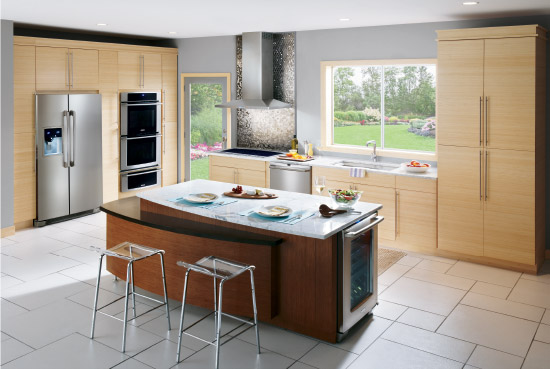 |
A well-designed residential kitchen benefits from the enhanced functionality and integrated forms afforded by built-in appliances. Photo courtesy of Electrolux |
Let's look first at the work area for receiving and storing food. The common functional elements here include cabinetry or pantry type storage for keeping food at room temperature. For perishable food that must be kept cool or frozen to be stored, the main appliance is the refrigerator/freezer. In all cases, planning for the right quantity of food storage is important for both perishable and non-perishable foods. The determining factor here is the size of the household and occupant lifestyle. A single person or working couple that eats out often likely has very different food storage needs than a large family with a vegetable garden in the back yard. Allowing for adequate refrigerated storage as well as room temperature storage, perhaps with some flexibility to add more as needs change, is a basic first step in kitchen planning.
Next, the work area for food cleaning and preparation comes into play. A work surface near the food storage area is useful for unpacking, cutting, mixing, or otherwise processing food. But quite importantly, a sink is needed for cleaning, rinsing, or draining during the food preparation process or for adding water when recipes call for it. Although a small dedicated food prep sink is sometimes used in larger kitchen layouts, it is more common that one sink is used for all cleaning and washing that take place in the kitchen. This means that washing of pots, pans, dishes, etc. will likely occur here and appliances such as a dishwasher and disposal will be logically located in this work area as well.
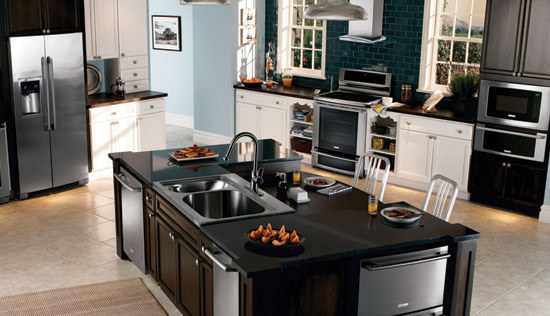 |
Kitchen planning principles identify three functional areas that work in concert with each other, the refrigerator area, the cooking area, and the sink area. Photo courtesy of Electrolux |
With the food taken from storage and appropriately prepared, it is now ready for cooking and serving. This third functional work area is extremely appliance centered with a diversity of choices in the type of cooking that can be done. Stove or range-top cooking is a time-honored tradition but can also include indoor griddle or grilling options. Ovens can be conventional or use convection fans to speed cooking times. And the ubiquitous symbol of modern busy lifestyles, the microwave oven needs to fit in somewhere appropriate to this work area. During and after cooking, adjacent work surfaces are needed to accommodate the addition of ingredients, place utensils or serving dishes, and generally support the cooking function of the appliances.
These three fundamental kitchen work areas, often appropriately referred to as the refrigerator area, the sink area, and the cooking area, together form the basis of a successful modern kitchen design. However, it is obviously critical that the three of them work together, are balanced in location, and each sized appropriately to their anticipated use. Since the sink area often supports the functions of the other two areas, it is typically located between them. The refrigerator area is often located near the entry to the kitchen to facilitate food storage while the cooking center is often located closer to the dining area to facilitate serving. Of course, there are reasons for variations to these typical conditions, some of which may include the addition of other work centers such as freestanding work islands or remote serving/staging areas. In all cases, however, the fundamental principle of the “work triangle” should be considered. Essentially, this approach acknowledges that a person working in a residential kitchen likely spends a good deal of time moving between the three core work areas, and more specifically, between the refrigerator, the sink, and the cooking appliances. Keeping the number of steps (i.e. the distance) between those three a minimum number means efficiency is increased. Spreading them out too far creates a need for unnecessary walking, poor workflow, and usually unhappy clients.
Laundry Design Principles
The primary functions of a laundry area are to wash and dry clothes. Additionally, it may also include pre-washing in a sink, sorting, ironing, and folding of clothes. Allowing space for all of these activities is important and either needs to occur directly adjacent to the washing and drying appliances or in another appropriate place. The workflow of the room or area should account for these various functions and the order in which they normally occur.
Beyond the working functions of the laundry area, its location in relation to the rest of the house and living spaces is significant. While locating the laundry in the basement or an entry area near the garage has been done for decades, it is clearly not the most convenient place for it to be located since clothes likely will need to be carried to and from there. A case is often made for locating the laundry on the main floor, often near the kitchen where the people in the residence can readily access it during the regular course of a day. Of course that still means that clothes may need to be carried up or down stairs and space needs to be allocated for sorting, folding, etc. Others advocate for it to be located logically near the place where most of the clothes are kept—the dressing areas of the house or bedrooms. In some cases, putting the washer and dryer right in the main dressing room could be logical, particularly if there are only one or two people living in the residence. In all cases, the role of the designer is paramount in determining how to best integrate the functions and appliances of the laundry with the form of the full residence.
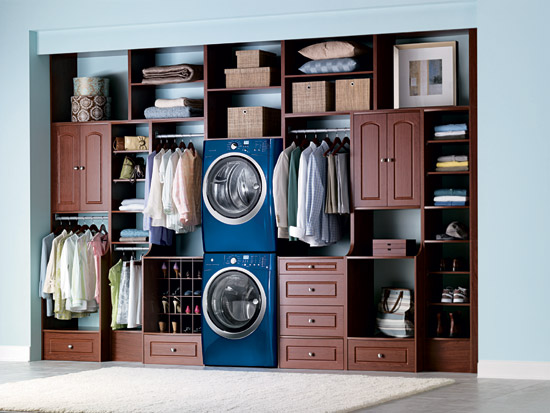 |
Laundry appliances can be integrated wherever they are the most useful, consistent with occupant lifestyles. Photo courtesy of Electrolux |
Kitchen Design Enhanced by Appliances
With a basic understanding of the driving design principles in kitchens and laundry areas, let's turn our attention to some of the key components of each—namely the appliances which dominate the attention of those using these spaces. We will start with kitchen appliances which enhance specific functions in all residential kitchens whether in new construction or renovation, single family or multifamily housing.
One of the distinctions to make right off the bat is the difference between appliances that appear to be “freestanding” and those that are “built-in.” The reality is that all appliances are separate, manufactured products that are installed into a kitchen. The distinction is whether or not they are secured in place to cabinetry or walls and trimmed out to look “built-in.” If so, then they are usually much more visually integrated and consistent with the design of the kitchen. In some cases, door panels on appliances can be customized to match the appearance of surrounding cabinetry or finishes while in other cases it may be advantageous to retain the look of finished metal such as stainless steel. Obviously there are distinctions in the way that appliances are made to accommodate the “built-in” appearance but there are also usually more choices in sizes, features, and options than for those that are easily disconnected and appear less visually integrated into a space.
Refrigeration Appliances
The most common refrigeration appliance is a combination refrigerator/freezer with choices on door configurations, size, and overall capacity. When designing so this appliance achieves a built-in look, there are several standard dimensions to consider regardless of the manufacturer or brand name on the appliance. The standard width of most full-size refrigerator/freezers is a nominal 36 inches with a standard height of approximately 69 inches.
The variable which will directly affect cubic footage capacity is the depth of the appliance. The standard depth is roughly 28-½ inches (not counting the depth of the doors) which means it is deeper than a conventional 24-inch-deep kitchen cabinet or a standard 25-inch-deep countertop. Hence, for a built-in look that is closer to being flush with kitchen cabinetry, a counter-depth refrigerator/freezer is available which is approximately 23-½ inches deep. In this case, cabinetry can be framed around the appliance which will protrude less into the workspace.
The cabinet-depth appliances will logically provide less cubic footage (on the order of 20 to 25 cubic feet) than standard-depth units (25 to 32 cubic feet) but variations in models and manufacturing approaches will impact this. Hence it is best to compare carefully to be sure that the designed opening for the refrigerator/freezer will meet the capacity requirements of the occupant/user.
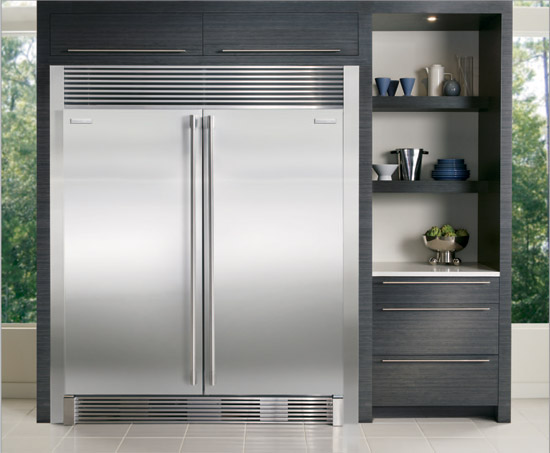 |
Separate full refrigerator and full freezer appliances can be built in to provide the clean appearance of one combined appliance. Photo courtesy of Electrolux |
To complete the built-in look, adding a manufacturer-supplied trim kit around the sides and top of the unit will eliminate any gaps and give the unit a completely finished look. Note that air must circulate around the unit to allow the heat transfer to occur out of the appliance so it can perform as intended. Depending on the make and model, a louver may be required above the appliance for air flow in addition to whatever air flow is built in to the bottom kick plate area. Check the specifications, clearances, cut out sizes, and air flow requirements published by the manufacturer to determine what is needed in a given design situation.
If a refrigerator/freezer appliance does not appear to meet the food storage needs of a user, then there are two fundamental options. Either increase the size to a larger unit or add supplemental refrigeration appliances. Generally, it is usually less costly and more energy efficient to run one larger refrigerator rather than two smaller ones. However, for design situations that call for a variety of notably different refrigeration needs including different temperature settings for significant quantities, then multiple units may be a logical choice.
Larger refrigeration appliances fall into two basic categories. First, a 6-inch-wider built-in refrigerator/freezer unit is commonly manufactured in a 42-inch nominal width. Typically, both the volume in the freezer and the refrigerator portions are increased, but direct comparisons between models is recommended to discern actual differences. Second, it is quite possible to select individual appliances that are all refrigerators or all freezers but each with the appearance of a standard refrigerator. These appliances are commonly narrower at a nominal 32 inches wide and a cubic volume less than 20 cubic feet, each. That is smaller than the total volume of the appliances described above, but when two units are used, it provides larger dedicated capacities for both refrigerator and freezer space. The two units can be separated in the kitchen based on workflow and convenience or they can be located next to each other to appear as one larger 64-inch-wide appliance.
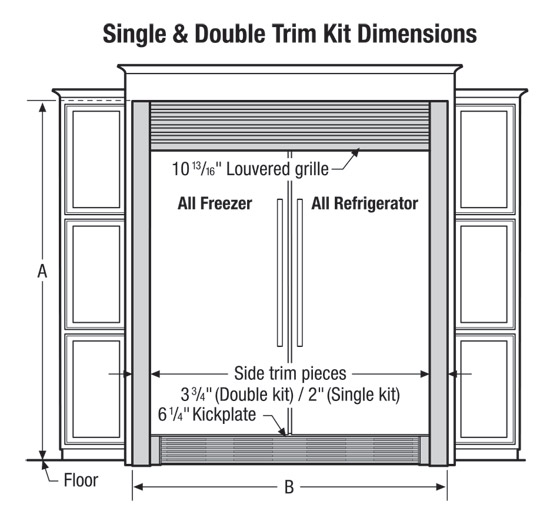 |
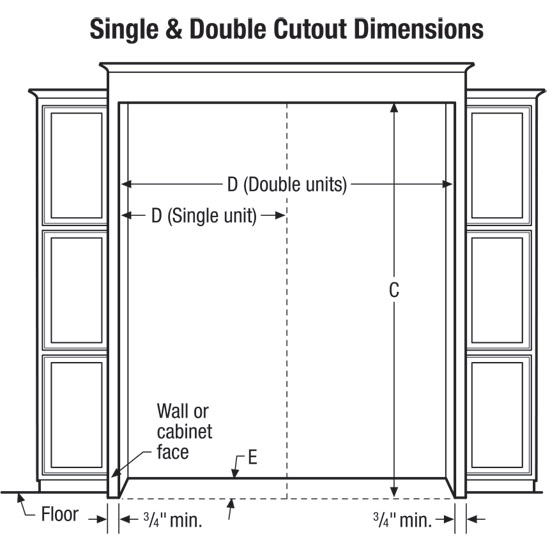 |
|
Images courtesy of Electrolux |
The choice to use multiple sizes and types of refrigeration appliances often comes down to specific needs. General-use refrigerators are typically kept between 35 to 38 degrees Fahrenheit for best food storage and efficiency of operation. This is colder than would be needed or recommended for wine storage for example which is typically in the 50 to 60 degree range.
If wine cooling is needed, then it may be more energy efficient and practical to use a separate appliance such as an under-counter wine cooler which can be set to the best temperature for this purpose. This leaves room in the main refrigerator for other uses or may allow for a smaller size to become practical. Similarly separate, smaller, under-counter ice makers may also be logical in situations where they are needed only occasionally and can be turned off in between uses. For other remote locations such as a wet bar or serving area, a smaller built-in refrigerator drawer may be all that is needed rather than a second full-size unit.
Cooking Appliances
Very often, the cooking work center and associated appliances make up a significant part of a kitchen design and layout. Choices abound in size, style, finish, function, and operation while owners will have a range of desires and needs working into the final selection decisions.
The first decision to make is the energy source to be used for cooking. There is an emerging trend to look at the best-performing energy source for a specific cooking appliance, even if it is different from other appliances in the design. Many improvements in electrical cooking appliances can make them the preferred option for even heating in ovens and some types of cooktops. Some people prefer gas-fueled cooking appliances simply because they think they offer a greater level of control than some electric ones, particularly with cooktop and range-top burners.
In response to these varied preferences, manufacturers offer a variety of interchangeable and independent appliances that use either gas or electric energy as their source. Some even offer an integrated “dual fuel” option with a gas range-top and electric oven all in one appliance. The potential downside to gas cooking appliances, of course, is the indoor air quality effects of gas combustion products. Therefore, including a ventilation fan that vents directly to the outside (not recirculating) becomes a significant component of gas cooking appliances. Keep in mind however, that selecting a conventional updraft hood or a downdraft hood can make a difference in the amount of make-up air that has to be heated or cooled to offset the exhausted air; downdraft hoods generally require several times more air than conventional updraft hoods.
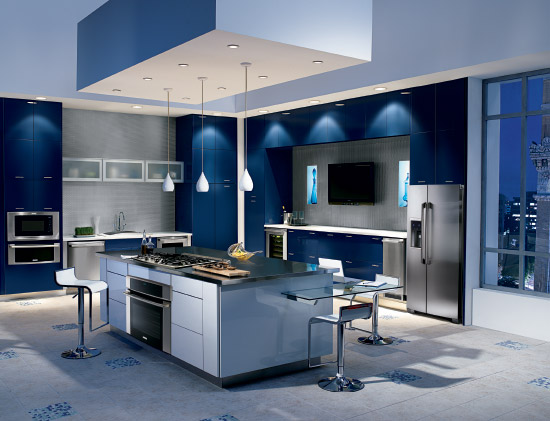 |
Cooking functions can be combined in a single appliance or separated into several built-in locations as needed to accommodate individual kitchen designs. Photo courtesy of Electrolux |
The next fundamental design decision to make is whether to use a range-type appliance which combines the cooking surface with an oven or to separate the cooktop and the oven functions. The range is obviously a space-efficient solution that can be further enhanced by placing a built-in microwave oven above it. Range-type cooking appliances come in a variety of sizes and configurations. The variable in the size is the width of the range while the height and depth generally match standard cabinetry.
The most common width is 30 inches which generally allows for four burners plus an oven and some standard options. However, for cooking centers that require more capacity or more options, units are commonly available in 36-inch and 48-inch-wide sizes. The configuration of burners, ovens, and other features vary by manufacturer, brand, or fuel type so it is worthwhile reviewing the options compared to user needs. Obviously, the larger the unit, the more space is needed not only for the appliance but for the workspace around it.
Separating out the cooktop from the ovens allows for different types of cooking functions to occur in different specific locations, which may be appropriate for high-use kitchens. It also allows for ovens to be raised up to a higher and more convenient mounting height when built into cabinetry or walls. When considering cooktops, fuel type comes into play in a rather practical manner since the appliance size, installation method, and connections will vary based on that choice. Fundamentally, however, the common methods include either sliding the cooktop into a customized cabinet or dropping them into a deep sump type of opening in a countertop. Either way the intent is to create a built-in look that flows and coordinates with the rest of the kitchen.
If an electric cooktop is selected, there are several choices in the type of cooking elements that are available. Radiant electric coils by comparison, are probably the most commonly thought of electric cooktop surface, but they are known for low ratings on appearance, functionality, and energy efficiency. Solid disk elements are more attractive than coils and they are easier to clean up. But since they heat up even more slowly than electric coils, and higher-wattage elements are generally used, energy consumption will be higher. Radiant elements under ceramic glass are easy to clean and heat up faster than solid disk elements, though not as quickly as conventional coil elements. The energy efficiency of ceramic glass cooktops is higher than coil or disk element cooktops. As with solid disk elements, flat pans are important.
Induction electric elements are the newest and most innovative types of cooktops. The induction elements transfer electromagnetic energy directly to the pan, where heat is needed. When the pan is removed, there is almost no lingering heat on the cooktop. As a result, they are very energy efficient, using significantly less energy than other standard cooking elements. In fact, in a separate comparison of different types of cooking systems and design strategies, induction cooking was found to be 20 percent more efficient than typical radiant electric, and 70 percent more efficient than gas. This analysis looked at light, medium, and heavy-duty cooking usage and found significantly the same advantage of induction elements in all three cases. Cooking with induction is also more responsive than gas or electric—heat levels can be instantly adjusted from a delicate simmer or up to a quick boil. Some manufacturers have even designed in specific controls to enhance the speed of heat level changes and a variety of induction element sizes for adaptability and flexibility in cooking areas. Further, different preset touch settings on the control panel can provide a level of digital heat responsiveness that inspires confidence in even the most particular chef.
When selecting separate built-in ovens, there are many alternatives primarily in terms of type of cooking method and special features. The trend is for wall ovens to be electric fueled on the belief that they provide more even cooking. The size is standardized to fit into cabinetry at 30 inches wide. Heights can vary based on the type of appliance selected and it is also possible to stack different units above each other in cabinets. Consider the following points:
• Conventional wall ovens. Whether gas or electric, self-cleaning models are more energy efficient because they have more insulation. Using the self-cleaning feature more than about once a month, however, will use more energy than is saved from the extra insulation.
• Convection ovens. These ovens can be more energy efficient than standard ovens because the heated air is continuously circulated around the food being cooked. Heat is distributed more evenly, and cooking time can be decreased. On average, convection ovens can reduce energy use and cooking time by 20 percent, compared to conventional ovens.
• Microwave ovens. Microwaves generally use one-half to two-thirds as much electricity as a conventional electric range or oven, particularly when used for reheating small portions. Because less heat is generated in the kitchen, residual savings may accrue from reduced air conditioning during the summer months.
• Warming drawers. Smaller warming drawers installed separately from ovens can be an efficient alternative to holding food at a slightly elevated temperature without the need to use an oven. Offering flexibility and control, they also use only the amount of energy needed for warming rather than full cooking.
When selecting the type and quantity of ovens for a particular kitchen, the proper clearances need to be accommodated both in terms of installation clearances in cabinetry or walls plus clearances in front to open oven doors.
Dishwashing Appliances
Built-in dishwashers are generally very standardized in terms of size and function for American kitchens. Allowing for their under-counter installation next to the primary sink in the kitchen is the most common and effective way to have them built in and support the dishwashing functions of the kitchen. This suggests that dish storage is located nearby as well which speaks to locating the sink/dishwasher in a central location in the kitchen.
The biggest differences between different dishwashers come from overall energy use and hot water use as drivers in dishwasher performance. A significant portion of the energy used by dishwashers is actually the energy required for heating the water they consume, since almost all dishwashers use internal booster heaters. That is actually a good thing, because it allows domestic hot water heater temperatures to be turned down to around 120 degrees, instead of the higher temperatures usually desired for dishwashing. The lower water heater temperatures mean less energy is used on an ongoing basis while the higher temperature is created only for the intermittent needs of the dishwasher. When selecting dishwashers, consider the following:
• Water usage. Specify a unit that requires less water overall and more options on controlling the water used. Many newer models have been documented to actually use half the water that conventional hand washing would require. Further, hand rinsing dishes can use up to 20 gallons of water before the dishes are even loaded.
• Rinse option. For times when dirty dishes sit overnight, a dishwasher with a rinse feature will typically use a fraction of the water needed to hand rinse.
• Load size. Dishwashers use about the same amount of energy and water regardless of the number of dishes inside, so sizing the unit to promote running full loads whenever possible will be appropriate.
• Drying. Specify units that have a no-heat drying option. This typically gives good drying results with less energy.
• Soil sensors. An additional significant specification detail is to call for a dishwasher that incorporates soil-sensors, since they adjust water use depending on how dirty the dishes are in each load. Recent improvements in test procedures better estimate the energy consumption of soil-sensing dishwasher models, allowing more accurate comparisons between models.
• Food disposing. Dishwashers for residential use fall into two basic categories—food-disposing where particles are drained with the rinse water and non-food disposing models where particles are collected in a strainer that must be emptied and rinsed manually. Machines in both categories may or may not have a filter, which generally comes in two types—coarse or fine. With coarse filters, food particles stay in suspension and can be re-deposited onto dishes after washing. As a result, a larger amount of rinse water is typically needed than in fine filtered models. Fine filter models generally have less food re-deposited, as most particles are filtered out prior to re-circulation in the wash cycle. Approximately half of the dishwashers sold are fine-filtered models and half have coarse filters or none at all.
Ventilation Hoods
In addition to providing a useful function over gas fueled cooking appliances, ventilation hoods serve some other purposes as well. First they help eliminate any smoke, excess heat, or cooking odors that may result from cooking. This presumes of course that they are in fact ventilating to the outdoors and are not simply re-circulating the air that passes through them. This function is performed whether the hood is wall mounted or isolated over an island up to ceiling outlet.
Beyond the functional performance of ventilation hoods, they can also create a strong visual statement since they are decidedly vertical element in what may otherwise be a series of horizontal lines and surfaces. Therefore selecting a ventilation hood with exposed ductwork in a finish that is complementary to the rest of the kitchen, such as stainless steel, can reinforce the cooking area a visual focal point. Since these units come with built-in lighting as well, they can contribute to the overall lighting scheme and balance the functional lighting needs in the kitchen with the visual ones.
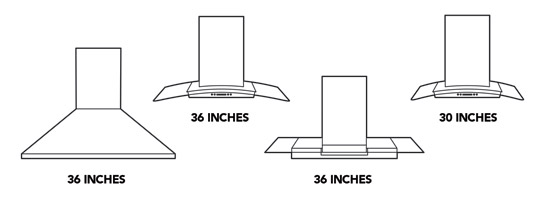 |
Ventilation hoods come in a variety of design enhancing shapes in sizes to match the cooking appliances that they serve. Image courtesy of Electrolux |
Laundry Area Creativity
New laundry equipment as discussed earlier can be located in a convenient laundry room to accommodate multiple functions or be integrated into clothes hanging or dressing areas. In either case, there are choices in how the washer and dryer appliances are arranged—either horizontally on the floor adjacent to each other in some fashion or vertically stacked on top of each other. When considering the layout, differences in the appliances will make a difference on the successful layout and function of any laundry area.
The first choice in laundry appliances is whether to use front-loading or top-loading appliances. Conventionally, residential washers have been top-loading while dryers have been front-loading although there has been a recent trend to use front-loading machines for both. These appliances operate by spinning on a horizontal-axis (hence the front-loading) and are generally much more efficient than conventional vertical-axis (top-loading) models. In washing machines this is attributed in large part to the fact that top-loading machines with agitators need to fill the tub completely with water while the horizontal axis machines do not. Hot water heating accounts for about 90 percent of the energy consumed by a clothes washer—only about 10 percent goes to the electricity to run the washer motor. Hence, specifications for washers should clearly address both energy and hot water usage. If water efficiency is a particular concern, note that washers are rated with a Water Factor (WF) that indicates the number of gallons needed for each cubic foot of laundry. The lower the WF, the less water needed to operate.
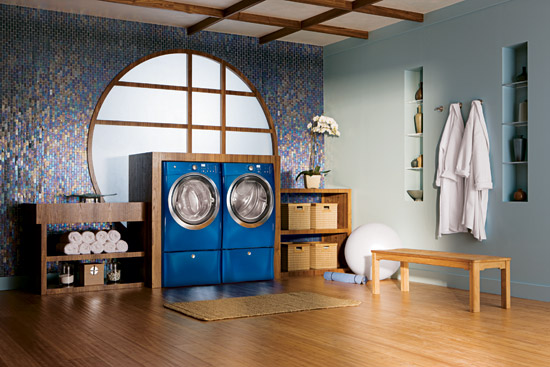 |
Front-loading or horizontal-axis washers and dryers are generally found to be more energy efficient than top-loading models. Photo courtesy of Electrolux |
When it comes to clothes dryers, the fundamental choice is between electric and gas-fired models. In terms of comparative energy use, gas dryers are generally less expensive to operate. However, most sources agree that there is not a lot of variation in overall energy actually used between models. Typically, it is usage and running time that dictate the amount of energy used. Therefore, controls for turning off dryers become the major consideration for energy consumption, particularly if coupled with an efficient washer that has extracted a lot of the water out of the clothes already. The fundamental controls choice is whether or not the dryer uses sensors to automatically turn off the dryer once clothes are dry. The alternative is timed drying, leaving the running time, and corresponding energy use, to the guesswork of the user. The best dryers have moisture sensors inside the drum for sensing dryness and turning off the machine. Most others only infer dryness by using temperature sensors in the exhaust air portion of the dryer, which may result in running the dryer longer than needed. Compared with timed drying, savings of about 10 percent with temperature-sensing controls and 15 percent with moisture-sensing controls are possible.
Specifying Performance Criteria in Appliances
When specifying appliances, there are two fundamental performance criteria that should be addressed the first is how much energy they use to operate since they all require some on an ongoing basis. The second is for water consuming appliances and is simply a measure of how much water they require to operate—particularly heated water.
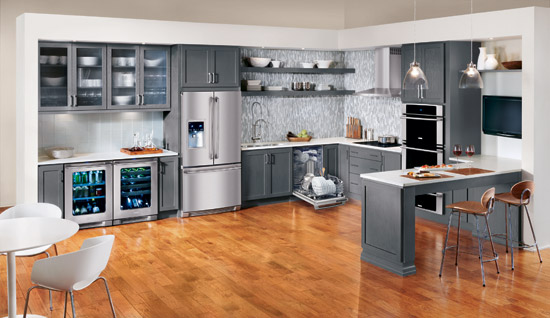 |
Specifying ENERGY STAR® appliances reduces operating usage and cost for energy and water without compromising design quality or other features. Photo courtesy of Electrolux |
Energy and Water Efficiency with the ENERGY STAR® Program
ENERGY STAR® is a well-known program of the U.S. Environmental Protection Agency (EPA) that provides a government-backed symbol for energy efficiency. It is intended to help consumers save money and protect the environment through energy-efficient products and practices. According to their web site, the ENERGY STAR label was established to “reduce greenhouse gas emissions and other pollutants caused by the inefficient use of energy and make it easy for consumers to identify and purchase energy-efficient products that offer savings on energy bills without sacrificing performance, features, and comfort.”
Kitchen and laundry appliances are a significant category of products within the ENERGY STAR program. Manufacturers can submit their information for review and verification by the EPA that they meet the requirements of the program in order to earn a coveted ENERGY STAR label. To qualify, appliances must minimally incorporate advanced technologies that use 10 to 50 percent less energy and water than standard models. In addition, all products need to demonstrate compliance with the following guiding principles as described by the EPA:
• Product categories must contribute significant energy savings nationwide.
• Qualified products must deliver the features and performance demanded by consumers, in addition to increased energy efficiency.
• If the qualified product costs more than a conventional, less-efficient counterpart, purchasers will recover their investment in increased energy efficiency through utility bill savings, within a reasonable period of time.
• Energy efficiency can be achieved through broadly available, non-proprietary technologies offered by more than one manufacturer.
• Product energy consumption and performance can be measured and verified with testing.
• Labeling would effectively differentiate products and be visible for purchasers.
Note that the specific criteria for achieving an ENERGY STAR rating for appliances is regularly updated and can change from year to year. In fact a significant change and upgrade for rating appliances is anticipated during 2014. Note too that specific individual models of appliances are rated, not entire brands of appliances. When specifying appliances it is currently appropriate to call for ENERGY STAR ratings on refrigerators, dishwashers and clothes washers. However the program does not currently rate cooking appliances or clothes dryers so specifications should reflect this accordingly. For all of these reasons, the ENERGY STAR website or printed reports should be consulted to determine if a particular appliance is rated or not. In addition, there are many other resources available, including those listed at the end of this article, so architects can readily find information to specify energy efficient and environmentally responsible appliances of all types.
Water use in appliances has become enough of an issue that the EPA is reportedly working on a water efficiency labeling program, similar to the ENERGY STAR® labeling program. Some ENERGY STAR models use half as much water as others, saving hundreds of gallons of water each year and corresponding savings in energy use. For example since about 60% of the energy used by a dishwasher goes towards heating the water, models that use less water also use less energy. Check the manufacturer's literature for ratings and water use on different makes and models. In some states, electric and water utilities offer rebates for the purchase of models that are exceptionally efficient.
Conclusion
Residential kitchen and laundry areas require high degrees of functionality to suit the needs of owners and occupants. They are also very visible areas that require high design standards since they can be very notable focal points of the residence. Built-in appliances address both the functional needs and the design needs with a wide variety of options and choices that allow for truly custom design solutions based on standardized construction and installation techniques. Architects that embrace kitchen planning principles and understand the depth and breadth of built-in appliance choices can use this knowledge to create truly outstanding designs that enhance and highlight the entire building design.
References: Green Design and Energy Saving Resources for Residential Appliances
• ENERGY STAR® is a government-backed program helping businesses and individuals protect the environment through superior energy efficiency. ENERGY STAR® program information and rated appliances models are found at www.energystar.gov
• U.S. Green Building Council (USGBC) and Leadership in Energy and Environmental Design (LEED) Standards are found at www.usgbc.org
• National Association of Homebuilders (NAHB) represents residential builders nationwide. www.nahb.org
• Enterprise Foundation and information on the Green Communities Initiative. www.enterprisefoundation.org
• American Council for an Energy-Efficient Economy (ACEEE) is a nonprofit organization dedicated to advancing energy efficiency and promoting economic prosperity and environmental protection. www.aceee.org
• Association of Home Appliance Manufacturers (AHAM) provides market industry trends on appliances. www.aham.org
• Appliance Recycling Information Center (ARIC) provides information on recycling appliances. www.aham.org/aric
• Consumer Reports' rates appliances. www.ConsumerReports.org
• Rocky Mountain Institute addresses energy and consumer issues. www.rmi.org
• The Green Guide is a GreenBiz news affiliate. http://www.thegreenguide.com
• Greenbuilder.com is an online resource with information about building and appliances. www.greenbuilder.com
 |
Electrolux is a global leader in household appliances and appliances for professional use, selling more than 50 million products to customers in more than 150 markets every year. The company focuses on innovations that are thoughtfully designed, based on extensive consumer insight, to meet the real needs of consumers and professionals. www.electroluxappliances.com |
